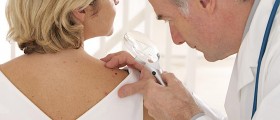
Even though there are certain skin lesions which are considered to be malignant and cancerous, a vast majority of these growths are actually benign. Some of the most commonly seen, benign, conditions are moles, freckles, skin tags, benign lentigines and seborrheic keratoses.
Moles and Their Causes
Almost every single person in the world has at least one mole on the surface of his/her skin. These growths are black or brown in most cases, appearing on just any part of our skin, alone or in groups. Most of the moles we have on our body form from our childhood until we reach the first half of 30 years of our life. By the time we reach full maturity, we are likely to have anywhere from 10 to 40 moles on our skin.
An interesting fact about moles is that they change as we grow older. Namely, they grow and develop, growing hairs, changing colors or expanding a bit. However, this is not the only scenario since many moles we have may disappear or remain the same throughout our life.
Moles are triggered by skin cells growing in clusters instead of spreading all over the surface of the skin. These abnormal cells contain pigmentation which grants moles their darker color. The cells are called melanocytes. In time, due to sun exposure, pregnancy or puberty, the moles we have may become darker.
Not Every Mole Is the Same
One in every 100 people gets moles before their moment of birth. These moles are called congenital nevi and possess a tendency for becoming malignant later in life. Moles which appear after we are born are not so prone to this metamorphosis. Cancerous moles are called melanomas and each mole should be checked for characteristics, ruling out this cancerous type, especially when the mole is bigger than 7mm in diameter.
Larger moles usually lack the round structure of the smaller ones. These are called dysplastic nevi, being unevenly colored and lacking round edges. People who have these kinds of moles and more than 100 of moles on their body altogether, have greater chances of developing melanomas in their life.
Malignant Moles
Usually, moles should represent no problems. However, if they change often, being prone to discoloration, growth, change of shape and other such mutations and if they appear after the age of 20, you should have them checked. Also, if a mole is causing you pain and discomfort or if it bleeds or produces discharge, you should react immediately, seeking medical assistance. The treatment will involve analysis after a biopsy. Then, if the mole appears to be malignant, further steps will be taken, usually involving surgical removal of the mole and stitching up the skin, closing the wound.

















Your thoughts on this
Loading...